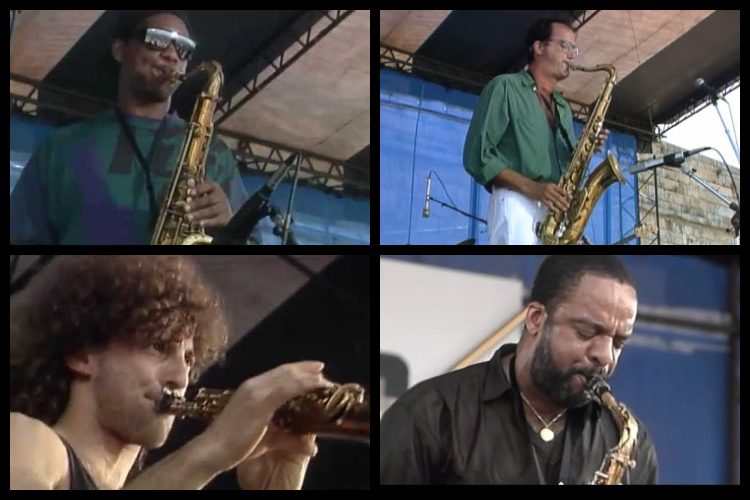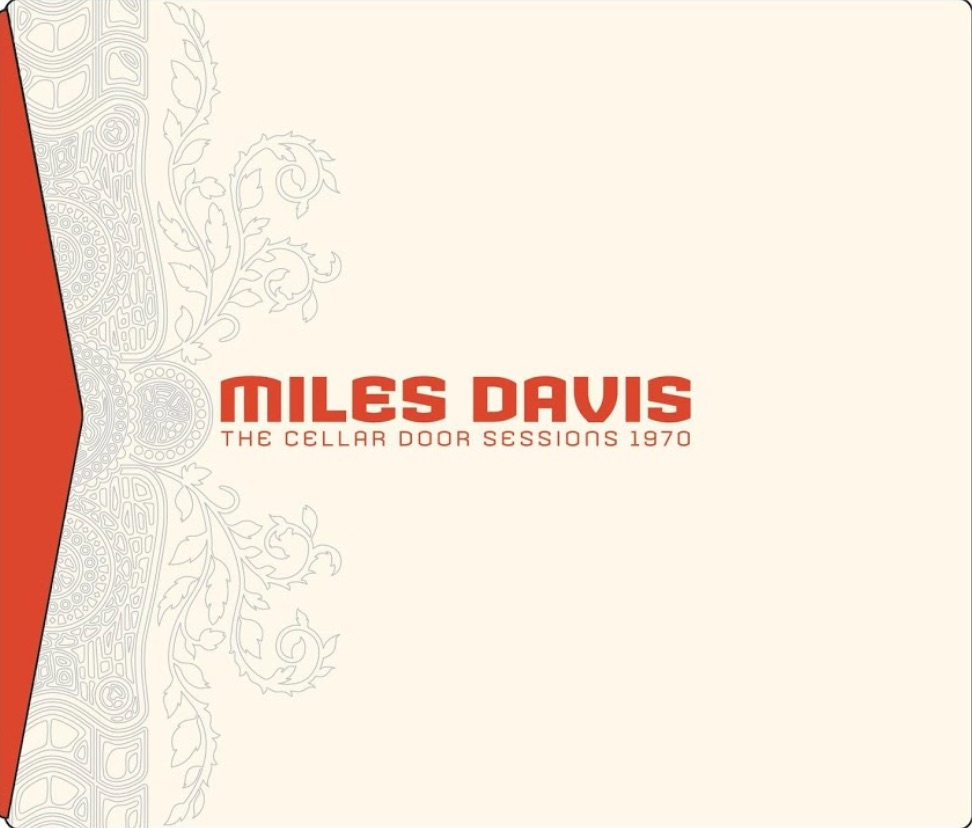A History of the Newport Jazz Festival – Chapter X: Smooth Sailing?, 1984-1989
|
Getting your Trinity Audio player ready...
|
Created in 1927, The Victor Talking Machine Company of Japan, Limited – more commonly known as Japan Victor Company (JVC) – was originally a Japanese subsidiary of America’s Victor Talking Machine Company. The parent was the most prominent photograph and record company of the era, renown for its Victrola record players. By 1929, the Victor Talking Machine Company was acquired by the Radio Corporation of America, better known as RCA, which is currently the second oldest record label in American history. As tensions began to rise between the two countries, RCA sold its interests in JVC to Nihon Sangyo, the predecessor to Nissan Motor Co., Ltd. JVC remained focused on making various radios and, in 1939, Japan’s first television.
World War II had a dramatic effect on the business. In 1943, the imperial government decreed it be renamed Nippon Onkyo (Japan Acoustics) and two years later its Yokohama plant was destroyed by aerial bombings. Almost 6,800 miles away, up to 3,000 soldiers stood on watch at Fort Adams for a potential Axis attack. One cannot overstate the poignancy that, at this same venue four decades later, the Japanese company – now retitled JVC – and the American Festival Productions Inc. would come together in peace to host an annual music festival. The partnership would prove incredibly fruitful; at one point they co-sponsored 150 events across the globe. Additionally, the businesses complemented each other well. By the 1980s, JVC was increasingly focused on video technology and the Newport Jazz Festival provided ample opportunities to test their new offerings. Although the Festival had been captured on film previously – most notably on Bert Stern’s Jazz on a Summer’s Day in 1958 – the new working relationship resulted in more video output of the event than any other time. Most of these would be aired on public television each year.
Their inaugural collaboration took place on Saturday, August 18, and Sunday, August 19, 1984. The thirtieth-anniversary event would present many names familiar to those at Newport over the years including Dizzy Gillespie’s All-Stars, Dave Brubeck’s Quartet, and Stan Getz’s Quartet.
Ray Charles and his Orchestra explored sounds similar to those which once brought him such acclaim on Modern Sounds in Country and Western Music (Capitol, 1962). Miles Davis kept pushing into new avenues with his band, fresh off of Decoy (Columbia, 1984)’s fusing of soul and electronica. B.B. King returned to Newport for the first time since the chaotic summer of 1971.
As has always been the case, the 1984 Festival also emphasized young talent with the Newport debuts of David Sanborn, Michel Petrucciani’s Trio, and Ronald Shannon Jackson and the Decoding Society. Flora Purim and Airto Moriera, who gave a standout performance at 1978’s Festivities in New York made their first appearance on Aquidneck Island. Tiger Okoshi, a trumpeter signed to JVC’s record label, performed as well.
With the success of the last several years of Jazz Festivals, George Wein set his sights upon expanding the musical offerings at Newport. After the 1971 riot exiled the Jazz Festival to New York, the sister Folk festival remained on permanent hiatus. For the summer of 1985, he revived the event, also at Fort Adams.
The 1985 Jazz Festival – split between August 17th and August 18th – continued to further mine the gentler sounds presented in 1983 with the return of Spyro Gyra. Other fusion acts included a quintet co-led by guitarist Lee Ritenour and keyboardist Dave Grusin and John McLaughlin’s reformed version of the Mahavishnu Orchestra. The emphasis on fusion was partly commercial reality and partly artistic choice. As Wein noted at the time, Festival Productions “wanted to make this a contemporary event [because] it is difficult to make a festival successful without bringing in fusion groups.” But that is not to say that respect for older traditions was unwelcome. Twenty-three-year-old Wynton Marsalis appeared shortly after the release of the album generally held as his finest to date, Black Codes from the Underground (Columbia, 1985). The Dirty Dozen Brass Band reflected the traditional New Orleans brass band sound. Freddie Hubbard presented a superpowered group with Richie Cole, Cedar Walton, Billy Hart, and Buster Williams. Favorites Sarah Vaughan and McCoy Tyner also performed with their groups. Saxophonist David Murray and his Octet made their first appearance at the festival. But perhaps the most memorable set came from guitarist Stevie Ray Vaughan and his band, Double Trouble, who were quickly rising as contemporary blues legends.
Youth bands had long been a part of the Jazz Festival’s history. Interestingly, despite the reborn Festival’s focus on families, there had not been a youth band performance at the Jazz Festival since its moving to Fort Adams. This changed in 1986 when the Rhode Island Youth Band opened festivities on August 23rd.
Guitarist Stanley Jordan – shortly after the release of his first major-label album, Magic Touch (Blue Note, 1985) wowed crowds with his ability to simultaneously play two parts on his instrument. John Scofield performed as well.
The weekend also reflected the era’s gradual demise of most powerhouse fusion bands that dominated the 1970s. Consider Wayne Shorter. Once the co-leader of the preeminent Weather Report, the group had ended by 1986 with the saxophonist now presenting songs from his first solo release in a decade, Atlantis (Columbia, 1985). Somewhat similarly, once Return to Forever guitarist Al Di Meola presented a solo set.
At the same time, the shift towards music drawing more from R&B than jazz continued unabated. Other than Gerry Mulligan and Miles Davis, many of the established acts which frequently appeared at Newport were absent in favor of vocalists Michael Franks and Natalie Cole and saxophonists George Howard and David Sanborn.
Since the Festival returned to Newport in 1981, it became increasingly ingrained in the city’s economic well-being, bringing many to the island each summer. However, it did not have sold-out crowds at the Fort as it once did at Festival Field or Freebody Park. That changed in 1987 with 7,500 attending each of the two days.
A large part of this jump in attendance was due to a yet further increased emphasis on “smooth jazz.” As in prior years, the approach did not entirely dominate the lineup. Dizzy Gillespie and Nancy Wilson both returned. As did Wynton Marsalis; his brother Branford additionally made his own Newport debut. Michael Brecker, who would emerge as one of the best post-Coltrane saxophonists over the next twenty years performed as well.
But the Crusaders and George Benson presented music that would appeal to the “smooth jazz” fan, bridging a gap between jazz and R&B. And then there was Kenneth Gorelick, a saxophonist whose recording Duotones (Arista, 1986) took the “smooth jazz” world by storm. Most dedicated jazz lovers did not give his music much artistic credence, pointing that to a perceived lack of substance and how he drew little from the jazz tradition. Nevertheless, many listeners loved him. His single “Songbird” even reached number four on the US Billboard Hot 100 in 1986, an unlikely feat for most instrumentalists. And while most purists could not appreciate his music, he was a seemingly unstoppable commercial force.
The increased focus on “smooth jazz” would also pervade the following two years of Jazz Festivals with about a third of the performances borrowing from the style or tiptoeing along its edges.
In 1988, this took the shape of saxophonist Najee and trumpeter/flugelhornist Chuck Mangione, both strongly associated with the “smooth” trend. While the latter was once a Jazz Messenger with hard bop icon Art Blakey, through the 1970s onward he increasingly focused on instrumental pop. Montgomery, Plant and Stritch, a cabaret-focused vocal trio interested the same audience. And, finally, 1988 additionally brought Grover Washington Jr. to Newport. The saxophonist, whose early flirtations on CTI with melding jazz and R&B, in turn, influenced much of the contemporary “smooth jazz” craze. He also showed earlier that decade the great commercial success such an approach could produce with the single “Just the Two of Us” (Winelight (Elektra, 1980)) rising to the top of the charts. And yet, he strongly avoided both the cliches for which the style was notorious and ever bending his artistic vision.
The 1989 Festival saw the return of Spyro Gyra and David Sanborn along with a Tuck and Patti’s gentle fusing of jazz and folk.
But, as in prior years, music more attuned to the jazz tradition was provided at each summer’s festival as well. In 1988 this came by way of Lionel Hampton, Chick Corea, Herbie Hancock, Carmen McRae, BB King, and the Count Basie Orchestra. The year was also special as it marked the official return of the Festival to its original home, the Newport Casino. Now the Tennis Hall of Fame, the Casino hosted the Festival’s Friday night concert, a tradition which continues to this day.
1989 saw the returns of Wynton Marsalis, Dianne Reeves, Branford Marsalis, Herbie Mann, George Wein’s Newport All-Stars, Mel Torme, Jimmy Smith’s Trio, Dave Brubeck’s Quartet, and Dizzy Gillespie with his Quartet. Yet, despite this, a casual observer would notice it was the “smoother” aesthetic that tended to bring crowds to the Fort. The question, as the Festival entered into a new decade was how long this trend would endure.
The 2021 Edition of the Newport Jazz Festival will take place from July 30th to August 1st at Fort Adams State Park. We plan to have live coverage of the event. More information can be found on the Festival’s website.




One thought on “A History of the Newport Jazz Festival – Chapter X: Smooth Sailing?, 1984-1989”